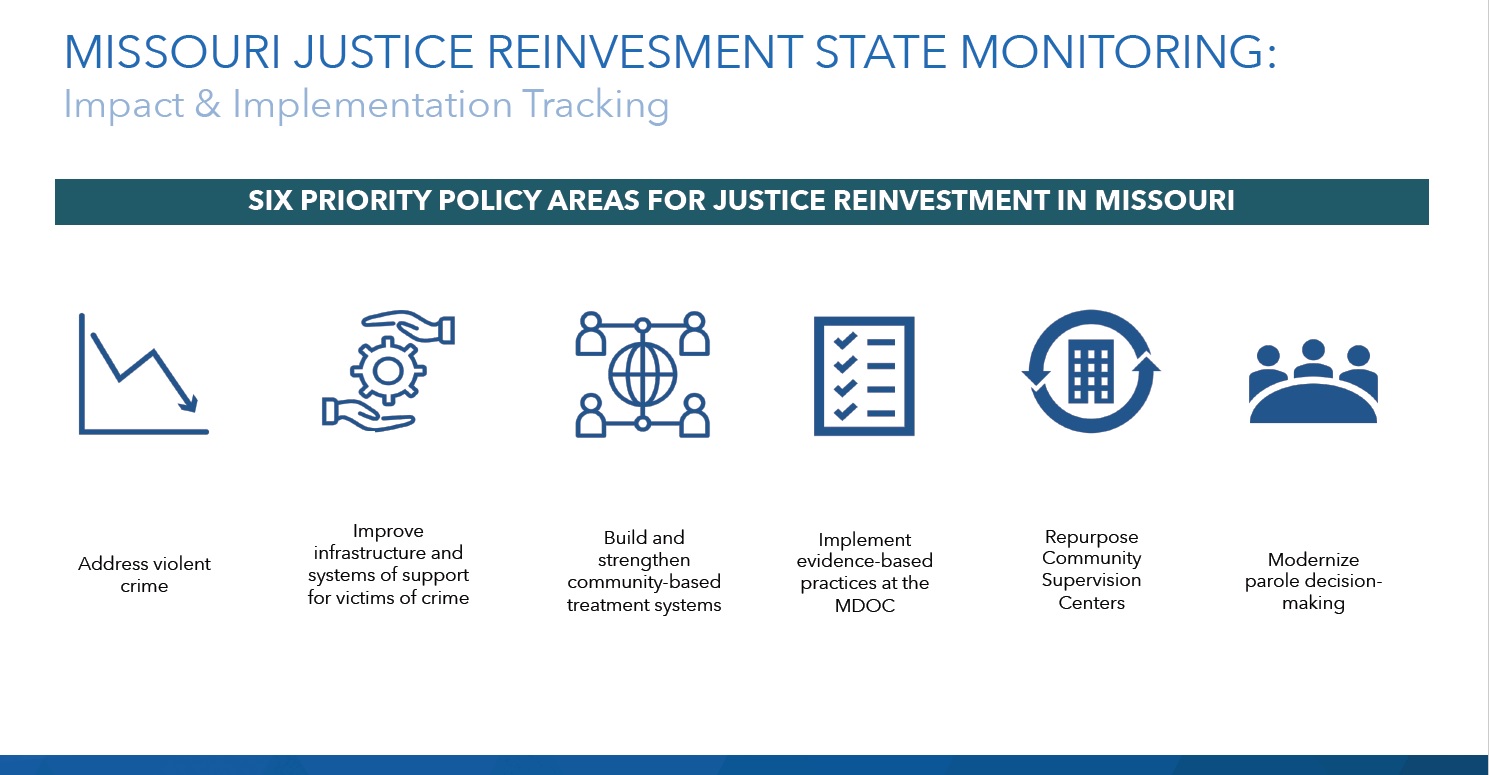When it comes to changing the mindsets and behaviors of people involved in the criminal justice system, we know that a cookie-cutter approach doesn’t work.
That’s why we’ve changed the way we do business.
In order to get the best results — to send people back out into the community better than they were when they came to us — we need to tailor our approach to the particular needs and strengths of each offender. The Justice Reinvestment Initiative (JRI) will help us get there.
The Justice Reinvestment Initiative is a way to give Missourians involved in the criminal justice system the tools they need to stay out of prison. With the money saved by incarcerating fewer people, the state can reinvest funds in programs that help to reduce crime and recidivism, making Missouri safer.
Background
In 2017, Missouri faced several criminal justice challenges, including rising violent crime rates and prison overcrowding. The bipartisan Missouri State Justice Reinvestment Task Force — which included state and local criminal justice system stakeholders —was formed to address the issues. The task force worked with the nonpartisan, nonprofit Council of State Governments (CSG) to gather and analyze Missouri criminal justice data. The council came away with several key findings. In 2017, Missouri had:
- The eighth-highest incarceration rate in the United States
- The fastest-growing female prison population in the United States
- An increasing violent crime rate but a decrease in violent crime arrests
- Insufficient behavioral health resources
- A high rate of prison admissions driven by factors other than new crimes; about half of new admissions were for technical violations of probation or parole
The task force worked with the Council of State Governments Justice Center staff to review analyses and develop policies and strategies to reduce violent crime, improve community-based treatment, reduce recidivism and increase public safety. Many of these policies are reflected in House Bill 1355, which was signed into law in June 2018.
What Justice Reinvestment Means for the Missouri Department of Corrections
- Commitment to evidence-based practices in corrections will improve how we assess offenders, build better case management plans, respond to positive and negative behavior, and equip staff with better programming and tools to reduce risk—all of which will enhance the chances of offender success.
- Offender success equals positive behavior in our facilities and reduced technical violations in the community. Improving lives not only makes communities safer, but saves correctional dollars.
The Main Changes
- The Ohio Risk Assessment System (ORAS) was adopted department-wide to assess offenders, target interventions, and inform responses to behavior.
- Treatment programs were piloted in Boone, Buchanan and Butler counties to provide intensive substance use disorder treatment services and to address barriers to treatment retention for offenders at the highest risk of incarceration. Programs now are being expanded to other counties.
- Community Supervision Centers (CSCs) were re-designed to target residential placement at the CSC for high risk clients in the CSC catchment area, who are in need of intensive programming in several criminogenic domain areas, and for whom traditional supervision in the community has been unsuccessful.
- The District 26 Community Supervision Center in Fulton transitioned to an all-female facility with program delivery that is both gender-responsive and trauma-informed, to better serve women under supervision in a rehabilitative environment — with the aim of reducing the number of women who are being incarcerated at an increasingly high rate.
- The ORAS Tools and Case Plan will be automated and shared by all divisions. Case managers and probation and parole officers can follow the assessment and case planning activities across the spectrum of incarceration, release planning, and field supervision.
- The Carey Group will deliver training to the Division of Adult Institutions (DAI) and Division of Probation & Parole (P&P) supervisors and managers in case management and planning to equip supervisors with the tools they need to support officers and case managers in the areas of assessment, case planning, and quality assurance. The Carey Group deliver case management and planning to case managers and probation and parole officers.
- Carey Guides and BITS tools are being adopted department-wide. Staff can use these guided intervention/skill practice worksheets to address certain behaviors and case-plan goals, which are accessible through an intranet link (BITS) and embedded in the University of Cincinnati (ORAS) case planning web application.
- The Case Management and Planning team has defined expectations for initial assessment and case planning, program placement, and the use of incentives and sanctions in responding to offender behavior, for both P&P and DAI.
- J-Pay tablets have been distributed to DAI offenders and currently allow offenders access to e-mail. In the near future, the tablets will allow access to other media and other applications based on offender behavior, at no cost to the department. The DAI Incentive Guide will provide a consistent menu of incentives that may be offered within the prison setting to motivate incarcerated offenders to demonstrate positive behavior.
- For DAI, the Offender Accountability procedure and revised conduct violation process were implemented in May 2019.
- For P&P, the Missouri Offender Management Matrix ties desired and undesired behaviors to the criminogenic domains of the ORAS, and provides a selection of appropriate responses to behavior based on the overall risk level for offenders under probation or parole supervision.
- Cognitive Behavioral Intervention-Substance Abuse (CBI-SA) programming is being piloted at several DAI and P&P locations. These programs are designed to address specific criminogenic risk areas identified by the assessment, rather than a one-size-fits-all approach for the department.
- The Difficult Discharge and Transitional Housing Unit teams have proposed recommendations to ensure timely assessment, identification and transition planning occur in support of addressing barriers to successful community reentry. These recommendations define the role of case-management, clinical and institutional parole staff in developing strong connections to needed resources in the field.
- The Institutional Parole Officer (IPO) role team has identified strategies to reduce duplicative workload, while continuing to provide critical information to the Parole Board in support of release decision-making and strengthening the vital role the IPO plays in connecting offenders leaving a DAI facility to employment, housing, and supervision resources prior to release.
- The Parole Board is pursuing the adoption of parole guidelines which incorporate the ORAS instrument as well as criteria to evaluate release readiness over several additional evidence-based factors thru a technical assistance project with the National Institute of Corrections.
- The Council of State Governments is completed a Justice Program Assessment (JPA) as part Phase II of Justice Reinvestment. The assessment provides a comprehensive analysis of current programming in DAI to determine what should be retained and what should be replaced with evidence-based interventions more suited to Missouri’s needs.



